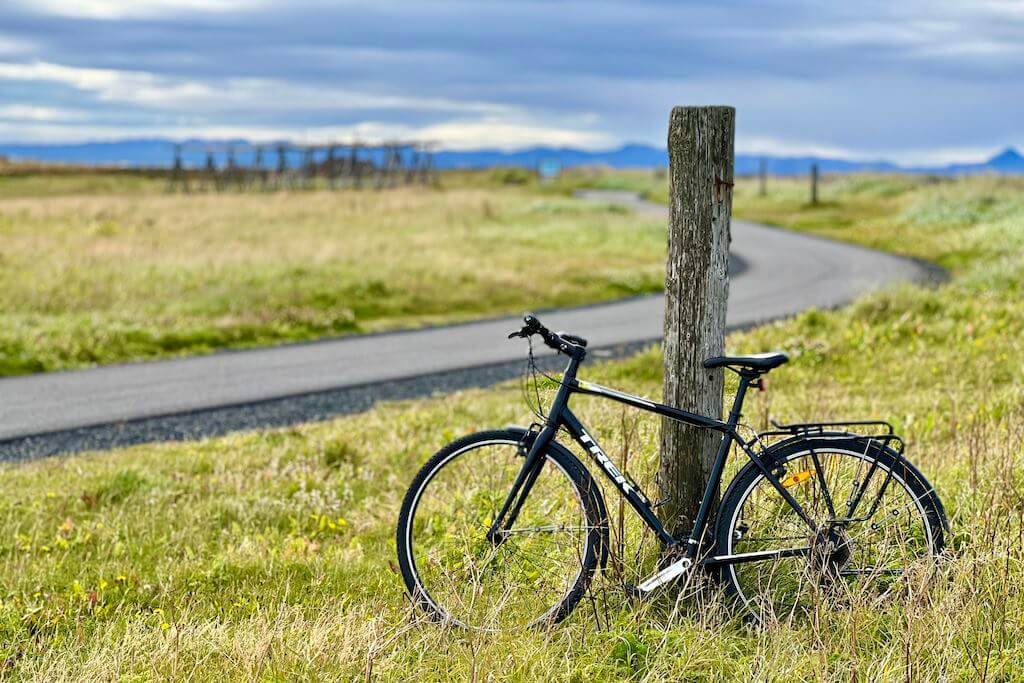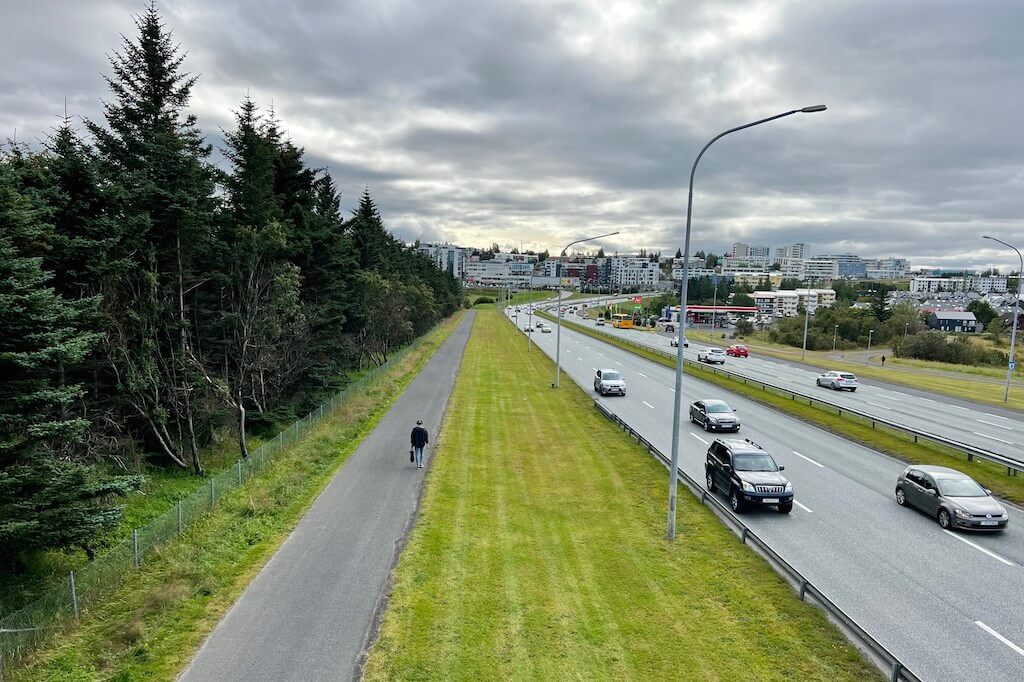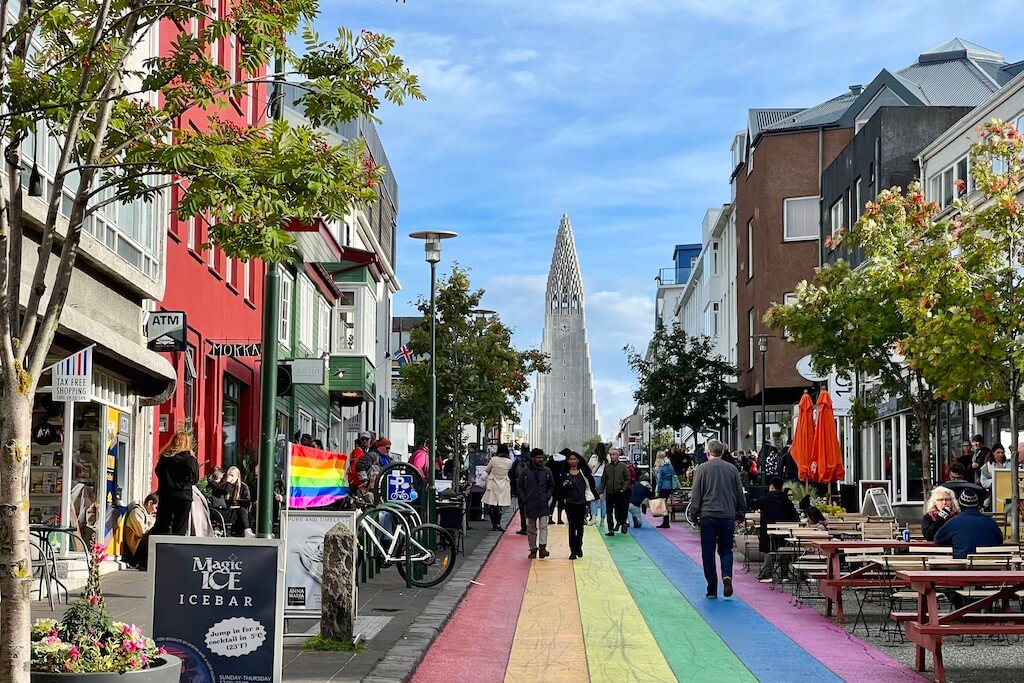A Bicycling Guide to Travel in Iceland
The name Iceland conjures a lot of images: volcanoes spewing lava, dark mountains glazed in glaciers, and Viking cottages covered in mossy roofs, to name a few.
But we’ll let you in on a secret: It’s also a very decent place to bike.

With its low COVID rates and Iceland Air’s many nonstop flights from North America, the mystical island has seen a tourism boom in recent years. (The prevalence of fluent English-speakers is also handy). Many daydreamers have learned about the Ring Road, a rideable highway that circumscribes the country, as well as the many gravel roads that crisscross the stark interior. You can find scads of rugged bikepacking videos online.
But bike-savvy travelers may also set their sights on Reykjavik, Iceland’s humble capital, where paths are plentiful and can lead you just about anywhere. With its meandering coast and navigable neighborhoods, Reykjavik is easy to explore on two wheels — and in the warmer months, a bike easily replaces a car for urban exploration.
Only about 130,000 people live in Reykjavik, but there’s a lot to see. Among its blocks of modernist gingerbread houses, the city packs a panoply of pubs, eateries, museums, and specialty shops. The streets are impossibly clean, and you can ride the maze of side-streets with the assurance that Reykjavik is considered one of the safest cities in the world.
So what is there to do, in a city so close to the Arctic Circle? Here’s just a sampling.
How to Get a Bike
There are several places to rent a bike in Reykjavik, and you can arrange every kind of organized excursion. One of the easiest services is Reykjavik Bike Tours, based in a converted shipping container on the waterfront. Bikes are diverse and affordable, and you can hit several trails in a matter of minutes. You can also rent from Borgarhjól, a respected shop on the fashionable Hverfisgata street. If you bring your bike from home, you can also visit Borgarhjól for maintenance and repairs.

Sadly, the WOW city bike service was short-lived, and as of this writing, no bike-share company has managed to replace it.
That said, ride-share scooters are insanely popular. Take a walk at any time of day, and you’ll see dozens of riders whizzing through the city on electric scooters. Two rival companies, Zolo and Hopp, have littered the streets with dockless machines, and anyone with the right app and a credit card is welcome to rent one.
Where to Go
The most blissful trip you can take is along the coastal bike path, which starts on the Reykjavik waterfront and winds its way around the peninsular town of Seltjarnarnes. The path is flat and smooth, and you’ll find uninterrupted views of nearby mountain ranges. The route leads you to the Grótta lighthouse and the Nauthólsvik Geothermal Beach, where swimmers can bask in earth-heated waters. The path also connects to commuter routes, which wind their way through the eastern suburbs.
City limits are only a few kilometers across, so you can zip from one hot spot to another with relative ease. Along the harbor, you’ll find the Saga Museum, with its vivid wax dioramas illustrating medieval Norse life, as well as the somewhat infamous Phallological Museum, which displays multi-species samples of the male member. The Harpa Concert Hall is a colossal, dark-tinted block; this performance space and music hall is, among other things, home to the Iceland Symphony Orchestra.
Farther out, you’ll find the Perlan (“The Pearl”), a domed complex that has become a popular planetarium and interactive natural history museum. The Reykjavik Family Park and Zoo is a nice diversion for families, partly because of the modest collection of animals (reindeer, arctic fox, etc.) and also because of the dynamic playgrounds that surround it.
If you see nothing else, you must visit Hallgrímskirkja, Reykjavik’s spectacular central church. The structure is impossible to miss: The concrete spire punctuates the skyline, and the facade radiates out like a pleated stone cape. Hallgrímskirkja rises over a busy public plaza, overshadowing a heroic statue of Leif Eriksson. Admire the architecture, use the bell tower as a reference point for finding your way, and even take an elevator to the top for an unbeatable 360-degree view of the city.

Note: Central Reykjavik is built on several hills, so you may find yourself huffing up the narrow streets. Bike lanes are few, but auto traffic tends to be slow and respectful. Meanwhile, the outskirts have a good number of highways; trails often peter out or lack precise signage, and Google Maps doesn’t yet indicate Icelandic bike routes. Rest assured, you can pedal almost anywhere in the environs, but some destinations might require problem solving. Also, remember that all of this gets more complicated in the wintertime; they don’t call it “Iceland” for nothing.
Where to Eat
For a nation that subsisted primarily on lamb and fish for the past millennium, Reykjavik has an astonishing range of dining options – a palette that reflects the growing diversity of the city.
For traditional dining in an easy-to-find location, visit Kaffi Loki, which stands directly across from Hallgrímskirkja. Here you’ll find such classics as fermented shark, mashed fish, and meat soup, all served with refined presentation.
Icelanders have adopted fish and chips, and you can find a number of places for this English standby, including Reykjavik Fish-Restaurant.
For a much, er, wilder experience, try to track down the Silli Kokkur food truck. It’s hard to believe Iceland has food trucks, given the climate, but they’re quite popular, and Sigvaldi Jóhannesson is a chef who hunts his own game before hacking the meat into ingredients. You can’t beat him for “locally sourced,” and Jóhannesson has won international awards for his culinary work.

Where to Stay
Central Reykjavik is packed with hotels of all sizes and styles, and AirBnB and Vrbo are saturated in rooms and apartments. If you’re traveling in the summer, though, plan to book your accommodations months in advance; reserving in the high season is a cutthroat experience, and rates will skyrocket come May.
Note: Visitors are often surprised how far Reykjavik is from its own international airport, which lies nearly an hour away by car. There’s no “budget” way to get from Keflavik International to Downtown Reykjavik; you’re more or less required to take a Flybus (about US$30 per rider) or, if you have a large group, you can hire a large cab for between US$150 and $200. It’s a rude awakening, when you first arrive in Iceland, where prices can already be daunting. But the in-person hospitality more than makes up for it. Skál!
Check out more bicycle city guides here.

